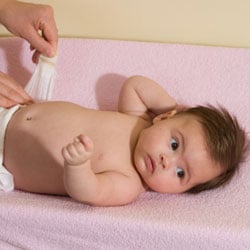
Falls in young children
10 January 2009
Falls in and around the home are the leading cause of injury in young children.
A young child’s head is heavier than the rest of his body, which increases the risk of toppling over.
They lack judgment and their motor skills are not fully developed.
Constant supervision is important.
Crib and changing table
- Only use a crib made after 1986 which meets current Canadian safety regulations.
- Health Canada does not recommend using cribs older than 10 years.
- Never let your child sleep on an adult bed or sofa.
- Remember to lower the crib mattress when your baby reaches three to five months of age and/or when your baby begins to push up on to their hands and knees.
- Avoid placing the crib or any furniture near windows.
- Maintain constant hand contact with your baby on a changing table; do not turn around or leave your baby alone, even for a single second.
Child restraints
- Never place your baby in an infant or car seat on a table, countertop or car roof. The safest place is on the floor.
- Always secure safety straps when your child is in a swing, high chair, stroller and car seat.
Falls from windows
Screens are a weak barrier and give a false sense of security. They are great for keeping insects out but are not strong enough to keep children in.
- Use window guards, which create a protective barrier, or window stops that limit the amount the window can open. Windows should not be able to open more than 10 cm (4 inches). These devices are available at hardware stores.
- Do not put furniture in front of the window. Young children are most at risk, as they are curious and can easily climb onto the furniture and have access to the window.
- Check to see if there is a municipal window safety by-law. If so, tenants living in an apartment should make sure that the landlord places window guards or stops. New homeowners should make sure that the contractor places window guards or stops.
Considerations for other rooms in the house
- Block stairs with safety gates. Only use safety gates that screw into the wall at the top of the stairs. Pressure gates can give way causing your child to fall.
- Baby walkers are dangerous and have been banned in Canada since 2004.
- Do not let your child play in the bathroom; its surfaces are hard and slippery.
- Never leave your child unattended on a balcony and make sure there are no chairs to climb.
- Supervise older siblings while they are holding your baby, preferably while sitting down.
- Do not place a fussy baby on a washing machine or dryer to soothe his/her colic.
Shopping with your child – shopping carts
Shopping cart related injuries are common in children younger than 5 and can result in serious injury.
The Emergency Department at the Montreal Children Hospital sees on average 20 children a year having fallen off shopping carts. The most common injuries seen are head and neck injuries, as well as fractures.
RECOMMENDATIONS:
- Be aware of the potential for cart instability causing falls and tip-overs.
- Avoid using shopping carts if possible. Seek alternatives such as making your older child walk; or placing your baby in a stroller and bringing another adult with you to look after the baby while you are shopping.
If you choose to use a shopping cart, is important to:
- Constantly supervise your child.
- Use age and size appropriate restraints at all times. This also applies to mini cars attached to the wagon.
- Never leave your child unattended or be more than an arms length within reach.
- Never allow your child to stand in the shopping cart.
- Never place an infant carrier on top of the shopping cart
- Never allow your child to ride on the outside of the cart.
- Never allow your child to push a shopping cart. It is too large for a young child to manage and can easily tip over.
Bunk Beds
Half of injuries seen due to the use of bunk beds occurs in children under the age of 4.
- Follow the safety recommendations according to the manufacturer’s guidelines.
- Never place the bed next to a window, blinds and curtains with cords, ceiling fan or light fixture.
- Always use the safety rails on both sides of the upper bunk. Keep the safety rails on at all times, regardless of your child’s age.
- Children under 6 years of age should not sleep on the upper bunk.
- Educate your child about the potential risks, such as fall from a height (which are common causes of injuries in children in general). Injuries can occur when your child is not only sleeping but also playing around or on the bed, or climbing down the ladder.
Related articles
Reviewed by Trauma specialists at the Montreal Children’s Hospital.
June 2020
